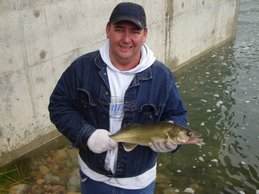Well I am back with my second article and it is exciting to see how many people are interested in the fun of fishing. These articles are meant for everyone. Some of the more experienced anglers probably know a lot about what I am talking about already but I think back to when I knew nothing about fishing. I wish there would have been something like that. Eventually this will be an eBook so take advantage of it while you can.
Okay now were going to talk a bit about rods and reels but mostly reels.
A reel is a device which lets you store an excessive amount of line on it. They allow you to cast way farther, fish in deeper water, retrieve your hook easier and in the case you get a big fish on you can control the fight much easier. The four types are fly, bait caster, spin cast and spinning.
Spin casting
We will start with spin casting because it is the easiest to use and it’s great for newbie’s just getting into fishing. The fishing line comes out of a small hole at the front of the reel. It goes down a straight handle to small guides. These reels are great for fishing pan fish such as perch or crappy.
Spinning Reel
A spinning reel is often called an open face real. The reason for this is because there is no covering on the line. The reel mounts underneath the handle and you can cast further because with the open face it allows the line to come off the reel with less restriction.
Bait caster
The bait caster usually has a straight handle. Once again the guides run on top of the reel. A bait caster is quite difficult to learn with because the reel turns with the line when you cast so if you’re not careful this is the easiest and quickest way to make a mess of your line that you probably won’t recover from without cutting the birds nest out.
Fly Fishing
In fly fishing the reel is really only used for one thing and that is to hold your line. The other reels use weight to carry your hook to where you want it to go but in fly fishing you have to use several arm and wrist techniques. Another thing that is important in fly-fishing is your momentum.
The one thing that is the same for all of these especially for beginners is that you will need practice to learn how to work them. Some are harder than the others with fly-fishing being the hardest but with practice everyone can become experts at the sport of fishing.
This will be the end of my second edition of my series on fishing. Keep reading my articles as they will get more informative and detailed as time goes on.
Dale Mazurek
Dale is an expert self taught fisherman of more than 35 years. He would like to share his expertise and stories with the world. You can check out his fishing blog at http://fishingtutor.blogspot.com. Dale is also a self taught author who is currently in the process of getting his first novel published. You can check his writings and lessons at http://stcajo-readshortstories.blogspot.com/
I am writing this for everyone young, old, big or small. The teachings in this series will range from novice to advanced. But I would just like everyone to remember that a bad day of fishing is better than a good day at work
Sponsors
Subscribe to:
Post Comments (Atom)




No comments:
Post a Comment